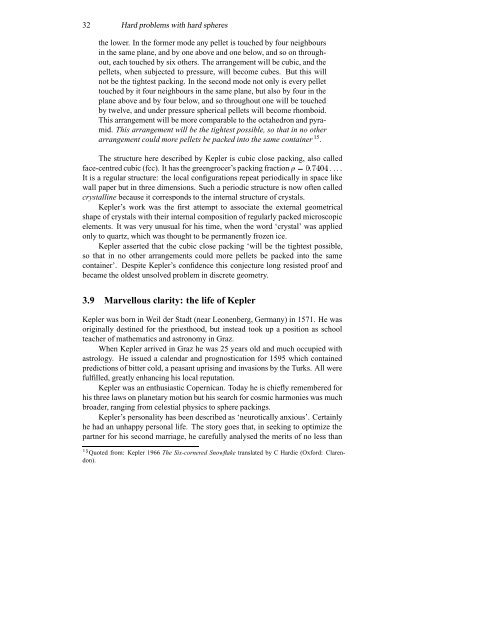Aste T., Weaire D. Pursuit of perfect packing (IOP 2000)(147s).pdf
Aste T., Weaire D. Pursuit of perfect packing (IOP 2000)(147s).pdf
Aste T., Weaire D. Pursuit of perfect packing (IOP 2000)(147s).pdf
You also want an ePaper? Increase the reach of your titles
YUMPU automatically turns print PDFs into web optimized ePapers that Google loves.
32 Hard problems with hard spheres<br />
the lower. In the former mode any pellet is touched by four neighbours<br />
in the same plane, and by one above and one below, and so on throughout,<br />
each touched by six others. The arrangement will be cubic, and the<br />
pellets, when subjected to pressure, will become cubes. But this will<br />
not be the tightest <strong>packing</strong>. In the second mode not only is every pellet<br />
touched by it four neighbours in the same plane, but also by four in the<br />
plane above and by four below, and so throughout one will be touched<br />
by twelve, and under pressure spherical pellets will become rhomboid.<br />
This arrangement will be more comparable to the octahedron and pyramid.<br />
This arrangement will be the tightest possible, so that in no other<br />
arrangement could more pellets be packed into the same container 15 .<br />
The structure here described by Kepler is cubic close <strong>packing</strong>, also called<br />
face-centred cubic (fcc). It has the greengrocer’s <strong>packing</strong> fraction ¼¼ .<br />
It is a regular structure: the local configurations repeat periodically in space like<br />
wall paper but in three dimensions. Such a periodic structure is now <strong>of</strong>ten called<br />
crystalline because it corresponds to the internal structure <strong>of</strong> crystals.<br />
Kepler’s work was the first attempt to associate the external geometrical<br />
shape <strong>of</strong> crystals with their internal composition <strong>of</strong> regularly packed microscopic<br />
elements. It was very unusual for his time, when the word ‘crystal’ was applied<br />
only to quartz, which was thought to be permanently frozen ice.<br />
Kepler asserted that the cubic close <strong>packing</strong> ‘will be the tightest possible,<br />
so that in no other arrangements could more pellets be packed into the same<br />
container’. Despite Kepler’s confidence this conjecture long resisted pro<strong>of</strong> and<br />
became the oldest unsolved problem in discrete geometry.<br />
3.9 Marvellous clarity: the life <strong>of</strong> Kepler<br />
Kepler was born in Weil der Stadt (near Leonenberg, Germany) in 1571. He was<br />
originally destined for the priesthood, but instead took up a position as school<br />
teacher <strong>of</strong> mathematics and astronomy in Graz.<br />
When Kepler arrived in Graz he was 25 years old and much occupied with<br />
astrology. He issued a calendar and prognostication for 1595 which contained<br />
predictions <strong>of</strong> bitter cold, a peasant uprising and invasions by the Turks. All were<br />
fulfilled, greatly enhancing his local reputation.<br />
Kepler was an enthusiastic Copernican. Today he is chiefly remembered for<br />
his three laws on planetary motion but his search for cosmic harmonies was much<br />
broader, ranging from celestial physics to sphere <strong>packing</strong>s.<br />
Kepler’s personality has been described as ‘neurotically anxious’. Certainly<br />
he had an unhappy personal life. The story goes that, in seeking to optimize the<br />
partner for his second marriage, he carefully analysed the merits <strong>of</strong> no less than<br />
½ Quoted from: Kepler 1966 The Six-cornered Snowflake translated by C Hardie (Oxford: Clarendon).

















